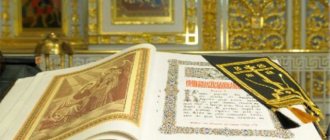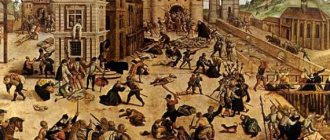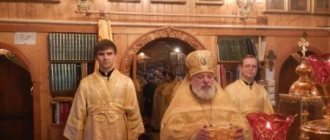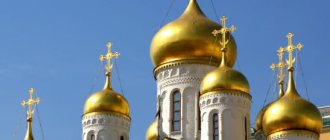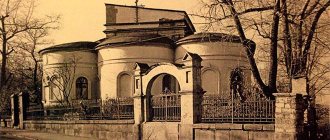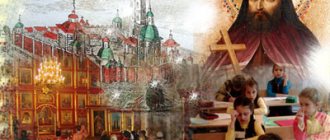Union
(church; lat. unio - union), a merger of the Orthodox and Catholic confessions, and, on the one hand, the primacy of the pope, purgatory, the procession of the Holy Spirit and from the Son (filioque) is recognized, on the other hand, marriage of white clergy and worship in their native language is allowed language, preserving oriental rituals.
In the middle of the century. There followed a complete break between the Eastern and Western churches. Instead of the previous peaceful relations, hostile relations were established between them. Through cruelty and desecration of Greek shrines during the Crusades, the Latins even made these relations hostile. The Greeks hated the Latins as heretics and their oppressors: the Latins, in turn, hated the Greeks as schismatics (as they called them) and as double-minded and treacherous people. Hostility often expressed itself in bloody clashes.
Despite this, the Greeks and Latins often make attempts to unite churches. There were special reasons that prompted them to seek church union. Even after the division of churches, the popes did not lose hope of subjugating the Greek-Eastern Church to their power. In these forms, they strove with all their might to restore communion between the Eastern and Western churches, understanding by restoration of communion not a union of churches, but the subordination of the Eastern Church to the Western Church, or, what is the same, to the pope.
The Greeks, for their part, also sometimes thought about uniting churches, according to political calculations. The political situation of the Byzantine Empire since the 12th century. it was extremely difficult. The decrepit empire, under the blows of the Turks and crusaders, was inclined to fall. Counting, with the assistance of the popes, to protect the empire from numerous enemies and protect it from fall, Byzantium sought an alliance with Rome; and since the popes could not be won over in any way except by expressing readiness to unite the churches, with the subordination of the Eastern Church to the Western, the Byzantine government in all negotiations with Rome brought to the fore the issue of uniting the churches.
Thus, on both sides, calculation played the main role in mutual attempts, and this alone did not promise them success. The fragility of attempts to unite churches was also due to the fact that they did not have the character of universality, at least in the East. On the part of the Greeks, it was the emperors who were mainly concerned about the union of churches, but the majority of the Greek hierarchy and the people were always against the union, since they saw in it the subordination of the Eastern Church to the pope.
Of the many attempts to unite churches, generally unsuccessful, three are especially remarkable, brought to the end by all kinds of tricks and violence and accompanied by sad consequences for the Orthodox Church, these are:
- Union of Lyons (1274)
- Union of Florence (1439)
- Union of Brest (1596)
Union in Austria-Hungary
Among the peoples of Austria-Hungary who adhere to the union, the first place numerically belongs to the Rusyns (Ukrainians, Little Russians), co-tribes with the population of southwestern Russia. In the Austrian half of the monarchy they are almost the only representatives of the union, although not all belong to it; in the Hungarian half they make up a significant part of the Uniates.
Until 1772, i.e. Before the first partition of Poland, in the Austrian part there were no Uniates at all, and they were only in Hungary, so the history of the Greek Catholic Church (as it is officially called), as it concerns the Rusyns, is connected mainly with the history of Galicia - a territory densely populated Uniates. The population of Galicia went into union in the second half of the 17th and early 13th centuries; in 1772, only one Basilian (Bazilian) monastery in Manyava remained Orthodox.
The international treaty of 1772 allocated from Poland the dioceses of Przemysl, Lviv (without part of Podolia) and a significant part of Kholm and Lutsk. All of them belonged to the Kyiv metropolitanate, a representative of which remained in Poland, as did the bishops of the last two dioceses.
After the final partition of Poland and the settlement of the borders between Austria and Russia in Austria, the separate existence of the Kholm and Lutsk dioceses was abolished, their remains were annexed to Przemysl and Lvov, and the district of Kamenets-Podolsk was separated from the latter, although the Lvov archbishops retained the title of bishop of Kamenets.
In addition to political motives, these changes were also influenced by the fate of the Uniate Church in Russia. When the Uniate metropolitanate was destroyed in Russia in 1795, the Austrian government restored the former rank of Galician metropolitan and gave it to the Lvov archbishop (1808).
The territory acquired by Austria in 1772 had about 2,700 thousand inhabitants, the majority of whom were Rusyns, i.e. Uniates The national and religious isolation of the majority of the population from the Poles was news to the Austrian government. This circumstance was favorable for government policy regarding the Polish gentry. On the other hand, the Austrian government, regardless of this, had to take care of the church life of its new subjects.
The result of the four-century (religious, cultural and national) struggle of the Rusyns with the Poles was that when Galicia came under Austrian rule, the Greek Catholic Church was in extreme decline. “Latinists” and their various church institutions were scattered throughout the territory. The Uniate clergy was in complete spiritual, material and even social humiliation. This prompted a series of reforms on the part of the Austrian government. It destroyed, first of all, the obligation of the Ukrainian rural clergy, on an equal basis with the peasants, to serve corvee (1777).
The poor financial situation of the Uniate clergy was mainly a consequence of the extreme fragmentation of parishes. The government produced the so-called concentration of parishes, but carried it out on such a scale that the Rusyns began to protest, especially in view of the simultaneous decentralization of Latin parishes. In addition, the government assigned cash subsidies from a specially established (1782) fund to the poorest priests and senior clergy.
The right of patronage was regulated, in the sense of limiting the dependence of the clergy on the landowners (1784). Most of all, the government took care of improving education among the Greek Catholic clergy. Previously, access to this class was very easy, even for people who were barely literate. In 1774, Maria Theresa established St. Barbarians in Vienna so-called “Imperial General Greek Catholic Seminary” for the Uniates of the entire monarchy, the teachers of which were invited mainly Rusyns from Hungary.
This “Barbareum,” as the seminary was usually called, was of great importance throughout its existence for the Uniate Church in Austria-Hungary. Almost all of the most remarkable representatives of the local Ukrainian clergy were students of this institution. They brought from here not only knowledge, but also the spirit of reform that animated the emperor. Joseph II.
In 1784, at the University of Lviv, the same general seminary was established for Greek Catholics from Galicia and Hungary, and at the same time the previous episcopal seminaries in Lviv and Przemysl were closed. And here teaching was carried out in the spirit of the reforms of Joseph II, and the language of instruction was mainly Ukrainian. This seminary existed until the closure of Lviv University in 1806. In 1817 it was restored, but only for Galicians.
The Austrian government also acted as a judge between the white and black clergy in Galicia. Even in Polish times, there was a struggle between them over dominance. The Basilians (monks of the Order of St. Basil) took control of the dioceses. Lviv Bishop Lev Sheptytsky, in order to get rid of their predominance, decided to restore the former “Kriloshan councils” in the form of Latin chapters. Not only the Basilians, but also the Latin clergy rebelled against this. The government sided with the white clergy and established chapters in Lviv (1786, 1813) and Przemysl (1787, 1816). In 1779 it was allowed to elect priests who were not monks as bishops.
A further step in this anti-monastic policy was the closure in 1783 of more than 40 Uniate Basilian monasteries and the last Orthodox one in Manyava; their property was given to a religious foundation. This broke the meaning of the Basilians for a long time.
The same reformation spirit of the government was expressed in the closure of all fraternities (1782); the famous Lviv Stauropegian brotherhood was supposed to change its name and organization and turn into a society under the name of the “Lviv Stauropegian Institute”.
All these reforms significantly raised the material and spiritual level of the Greek Catholic Ukrainian clergy, and the appointment of a special Galician metropolitan raised the prestige of the Uniate Church.
In the 19th century the fate of the latter in Russia forced the Roman Curia to also take care of the Galician Greek Catholics. Metropolitan Mikhail Levitsky was given the title of cardinal (1856); The ban on the transition of Uniates to the Latin rite was confirmed (1863). This defense of the Greek Catholic rite did not, however, give it equality with the Latin; The Latin clergy did not cease to look at the Rusyns as half-infidel schismatics and continued their propaganda among them in favor of Latinism.
All this exacerbated religious antagonism. With all this, due to the lack of Rusyns in the first half of the 19th century. national self-awareness, higher education led their clergy to polonization. In 1772, the poor and ignorant white clergy still had a national Ukrainian character, but the higher educated clergy from the Basilians was almost completely denationalized. Later, almost all the clergy suffered the same fate.
A reaction against such an anomaly began among the clergy of the Przemysl diocese, which was under the administration of Bishop Ivan Snigursky (1818-1847), the most famous figure among the Greek Catholic clergy in all Austrian times. His activities were not limited to the development of national self-awareness among the clergy, but extended to the entire rural population.
The literary revival of the Rusyns had its first representatives only among the clergy (M. Shapshevich, Y. Golovatsky, I. Vagilevich, M. Ustyanovich, etc.). In 1848, the Rusyns clearly stated their national-political demands for the first time (Gr. Yakhimovich, Mikh. Kuzemsky, etc.). With the suppression of the revolution, political and religious reaction began in Austria. Thanks to the concordat of the Austrian government with Rome, the Catholic clergy acquired privileges unprecedented since the time of Joseph II in the fields of politics and public education (1855-1867).
And the Uniate clergy then acquired the right of supervision over public and secondary schools; but it did not use its powers particularly zealously, while the Latin clergy, in addition to religious propaganda, began to spread polonization in Galicia and Bukovina.
In national-political terms, the Uniate clergy was then distinguished by narrow-mindedness, callousness and stagnation, which came to be designated by the word “ruthenism.” And in terms of ritual, the Uniates began to gradually approach Latinism (the introduction of the holiday of Corpus Christi in 1854). The desire of the Roman Curia to convert the Orthodox East into a union finally forced the Ukrainian clergy in Galicia to begin to cleanse the Eastern rite of Latin impurities. A hot struggle arose, which for two decades filled the entire spiritual life of the Galician Rusyns. Some of the clergy even began to directly declare their sympathy for Orthodoxy. The case of Olga Grabar (1882), which caused a lot of noise in this sense, prompted the Roman Curia and the Austrian government to undertake reforms in order to bring the Uniate clergy and ritual closer to Catholicism.
The reform of the Basilian monasteries was transferred to the hands of the Jesuits (1882). Metropolitan Joseph Sembratovich, who was an opponent of this measure, had to retire. Under his successor Silvestre Sembratović, who received the rank of cardinal, reforms continued in the same spirit, especially in the field of rituals.
The Council of the Galician Clergy of 1894 returned to the resolution of the Zamoyski Council, according to which, first of all, monks and unmarried people should be appointed bishops. From among the monks came Metropolitan Count Andrei (Sheptytsky) (since 1900).
However, the council resolutely rejected Rome’s demand for general celibacy of the clergy. In 1893, the Barbareum was closed, in its place the College of St. Afanasia. The antagonism between both rites became even more acute. The government and the curia still looked at the union as something inferior compared to Latinism.
In Hungary, the Greek Catholic Church is in no way connected with the Austrian; The Rusyns make up only a minority of the total number of Uniates. They accepted the union in 1649 and constituted one Mukachevo (Munkacs) diocese, subordinate to the Latin archbishop in Eger. The Austrian government here too in the last quarter of the 17th century. carried out reforms in the sense of improving material life and educating the clergy.
The Barbareum and the Lviv General Seminary were for some time institutions common to the entire monarchy. When the Uniate metropolis was destroyed in Russia, the idea arose to establish a metropolis common to all Rusyns in Mukachevo, but when the metropolis was established in Lvov, the Hungarian Uniates were not added to it due to the hostile position occupied by the Magyars, and the Mukachevo diocese remained united with the Latin metropolis.
In 1821 it was divided into two, creating a new one, Presevo (Eperjes). Separate seminaries arose in each of them. Until 1873, a certain number of clergy were delivered to both dioceses by the Vienna General Seminary, until the Magyars put an end to this. And in Hungary from the middle of the 19th century. The clergy stood at the head of the national-political Rusyn movement, but the autonomy of Hungary (1867), the break with Galicia, the predominance of Catholicism and the lack of clear national ideas led to the fact that the Ukrainian (Ugro-Russian) clergy in Hungary almost completely became Omagyarized and separated from the people.
The largest contingent of Greek Catholics in Hungary are Romanians, mainly in Transylvania. Half of the Hungarian Romanians accepted union with Rome in 1699. The other part of the Hungarian Romanians belongs to the Orthodox Church. The Greek Catholics of Austria-Hungary formed a significant number of colonies in America (in the United States, in Canada, in Parana).
Structure
In the wake of religious freedom following the fall of communism, a small number of Russian Catholics called for an exarch to be appointed to fill the long-standing vacancy. Such a move would have raised strong objections from the Russian Orthodox Church, causing the Holy See to not act on ecumenical grounds. However, in 2004, the Vatican's hand was forced when a collection of Russian Catholic priests in the vacant exarchate used their rights under canon law to elect the father. Sergey Golovanov as temporary administrator. The Vatican then quickly replaced Father Sergei as a bishop. Joseph Werth, the Latin Church Apostolic Administrator of Siberia, based in Novosibirsk. He was appointed by Pope John Paul II as common to all Eastern Catholics in the Russian Federation. As of 2010, there are five parishes registered with the authorities. Siberia, while in Moscow two parishes and a pastoral center operate without official registration. There are also communities in St. Petersburg and Obninsk.[4] By 2022, 13 parishes and five pastoral centers were registered in Siberia, seven parishes and three pastoral centers in the European part of Russia. Some parishes serve the Ukrainian community. The Ordinariate has a minimal structure. And the Byzantine Catholic mitral archpriest serves as the secretary of the ordinary. There is a coordinating priest for parishes in Siberia, a liturgical commission and a catechetical commission.[10]
Outside Russia there are Russian Catholic parishes and religious communities in San Francisco, New York, El Segundo, Denver, Melbourne, Buenos Aires, Dublin, Meudon, Paris, Chevetogne, Lyon, Munich, Rome, Milan, and Singapore.[ needed quote
] All of them are under the jurisdiction of their respective local bishops of the Roman rite.
The communities in Denver, Dublin and Singapore do not have a Russian national character - they exist for local Catholics who want to worship in the Russian-Byzantine style.[ citation needed
]
As of 2014, the two exarchates of Russia and Harbin are still listed in the Annuario Pontificio
have been preserved, but they have not yet been restored, and new bishops of the Russian rite have not been appointed to head them.
- 1997 – 2004 Protopresbyter Sergei Golovanov
- 2004 - Present Bishop Joseph Werth (temporary)
Literature
- Bantysh-Kamensky, Historical news about the U. that arose in Poland, 1st ed., 1805, 2nd ed., 1866;
- M. Koyalovich, Lithuanian Church U., St. Petersburg, 1859 (here an extensive bibliography is given in the notes and a chronological list of polemical literature, modern U. is given);
- Metropolitan Macarius, History of the Russian Church, vol. 8 et seq.; With T. Golubev, Peter Mogila and his associates;
- V.B. Antonovich, Monographs on the history of Western Russia, vol. 1; V.G. Vasilevsky, Essay on the history of the city of Vilna; Kostomarov, Preparation of church teaching (“Monographs”, vol. 3); him, On the meaning of U. in the West. Russia, 1842;
- Flerov, About Orthodox church brotherhoods;
- A.A. Rapkov, Essay on the history of Western Russian Orthodox brotherhoods;
- I.A. Kulish, History of the Reunification of Rus';
- I. Slivov, Jesuits in Lithuania;
Recommendations
- Rocca, Francis X. (June 7, 2022). “Russian Catholics, feeling abandoned, turn to the Pope.” Wall Street Journal
. ISSN 0099-9660. Retrieved September 21, 2022. - "Russian Byzantine Catholic Church: between the Vatican and the Russian Orthodox Church." www.romereports.com
. Retrieved September 21, 2022. - "Apostolic Exarchate of Rus', Rus' (Russian Rite)". GCatholic
. Retrieved September 21, 2022. - ^ a b
Ronald Roberson. "Other Eastern Catholic Communities: Russians". Catholic Welfare Association Middle East. - “THE IMPORTANCE OF THE SHEPTYTSKY METROPOLITAN FOR HISTORY – Ukraine – Ukrainian Echo.” www.homin.ca
. Retrieved December 15, 2022. - "Blessed Leonid Fedorov." CatholicSaints.Info
. February 12, 2009. Retrieved December 15, 2022. - Internet, Catholic. “Bl. Leonid Fedorov - Saints and Angels. Catholic Online
. Retrieved December 15, 2022. - "Other Eastern Catholic Communities". CNEWA
. Retrieved December 15, 2022. - ^ a b
Zugger 2001 p.462 - https://www.rkcvo.ru/
The difference between the Catholic Church and the Orthodox Church
How are Catholics different from Orthodox? This question is very often asked by believers of both one and another faith. It is dictated by various reasons: both ordinary curiosity and the desire to understand the history of Christianity.
But most of all, the question of the difference between the Catholic Church and the Orthodox Church worries, oddly enough, the followers of these two religions - after all, it is always interesting to figure out what caused the contradictions and the great church schism.
To complete the picture, it should be clarified that, in addition to Catholicism and Orthodoxy, there is a third branch of Christianity - Protestantism. They all have dogmatic differences, which are the reason for the lack of Christian unity.
First of all, I would like to note that the Catholic Church, like the Orthodox Church, considers itself universal, that is, spread throughout the world.
The Catholic Church is one: all its parts in different countries profess the same doctrine, are in close communication and interaction with each other and recognize the Pope as their only head. Now we can move on to the differences between the Orthodox Church and the Catholic Church.
How Catholics differ from Orthodox Christians - dogmatic differences
The most important differences between the Catholic Church and the Orthodox Church, which became the cause of the contradictions that led to the schism, are dogmatic.
What are dogmas? In Christian practice, a dogma is a certain truth that, to one degree or another, reveals the essence of God, the Mother of God, and other issues of faith and church structure (for example, the dogma of the three persons of the Holy Trinity).
The dogma is distinguished by its uncompromising presentation - it can only be one way and no other, and must be perceived by believers in its entirety. There are several dogmas, the belief in which is the main difference between the Orthodox Church and the Catholic Church.
The main contradiction is the Catholic doctrine of the filioque, or the dogma of the procession of the Holy Spirit from both God the Father and God the Son. Let me remind you that Orthodoxy professes the procession of the Holy Spirit only from the Father. The second important dogma is the Immaculate Conception of the Virgin Mary, professed by Catholics.
He claims that Mary was born without original sin, which is characteristic of all people, but the Orthodox Church refutes this, believing that such a statement belittles the feat of the Most Pure Virgin, Who was born an ordinary person, but achieved Her holiness solely thanks to Her humility. The third dogma that defines the difference between Catholics and Orthodox is the infallibility of the Pope.
External differences between the Orthodox Church and the Catholic faith
Another significant contradiction, the confession of which Catholics differ from Orthodox Christians, is the dogma of purgatory.
Purgatory is a state in which a soul, unworthy of Paradise, but not deserving of hellish torment, remains in a kind of limbo.
While the soul is in purgatory, it can bring repentance to God and count on mercy. According to the Catholic faith, this is also facilitated by the fervent prayers of loved ones remaining on earth.
The external differences between the Catholic Church and the Orthodox Church are also significant, but not as fundamental as the dogmatic ones.
Among them are communion only with the Body (in Orthodoxy - Body and Blood), admission of children to communion only from 10-12 years of age (in Orthodoxy - from the moment of baptism), external differences in the conduct of services and the construction of churches.
However, it should be noted that the Catholic faith is divided into two directions - the Latin and the Eastern Rite (Greek Catholics), and the external differences between the Orthodox and the Eastern Rite Catholics are much smaller than with the Latin Catholics.
Source: https://www.sudba.info/otlichie-katolicheskoj-cerkvi-ot-pravoslavnoj/
